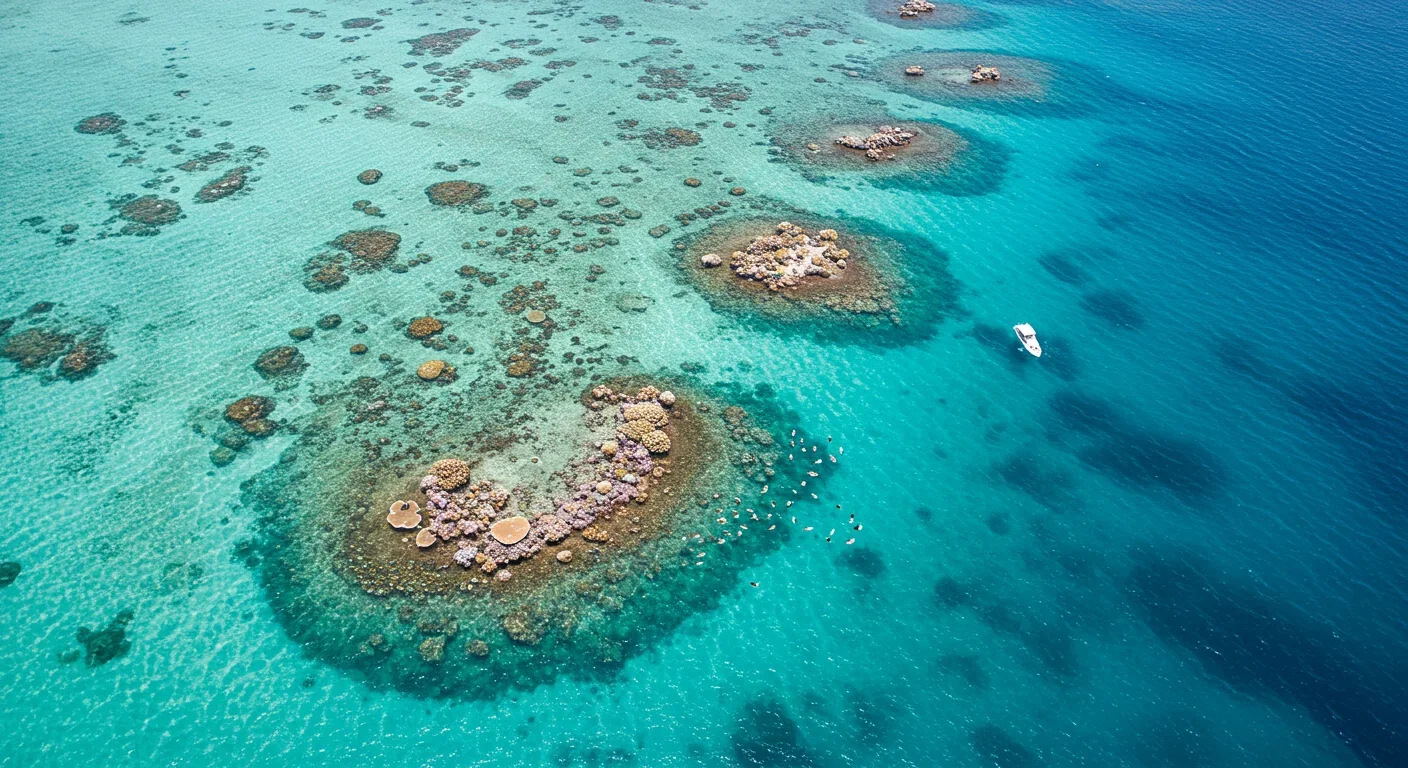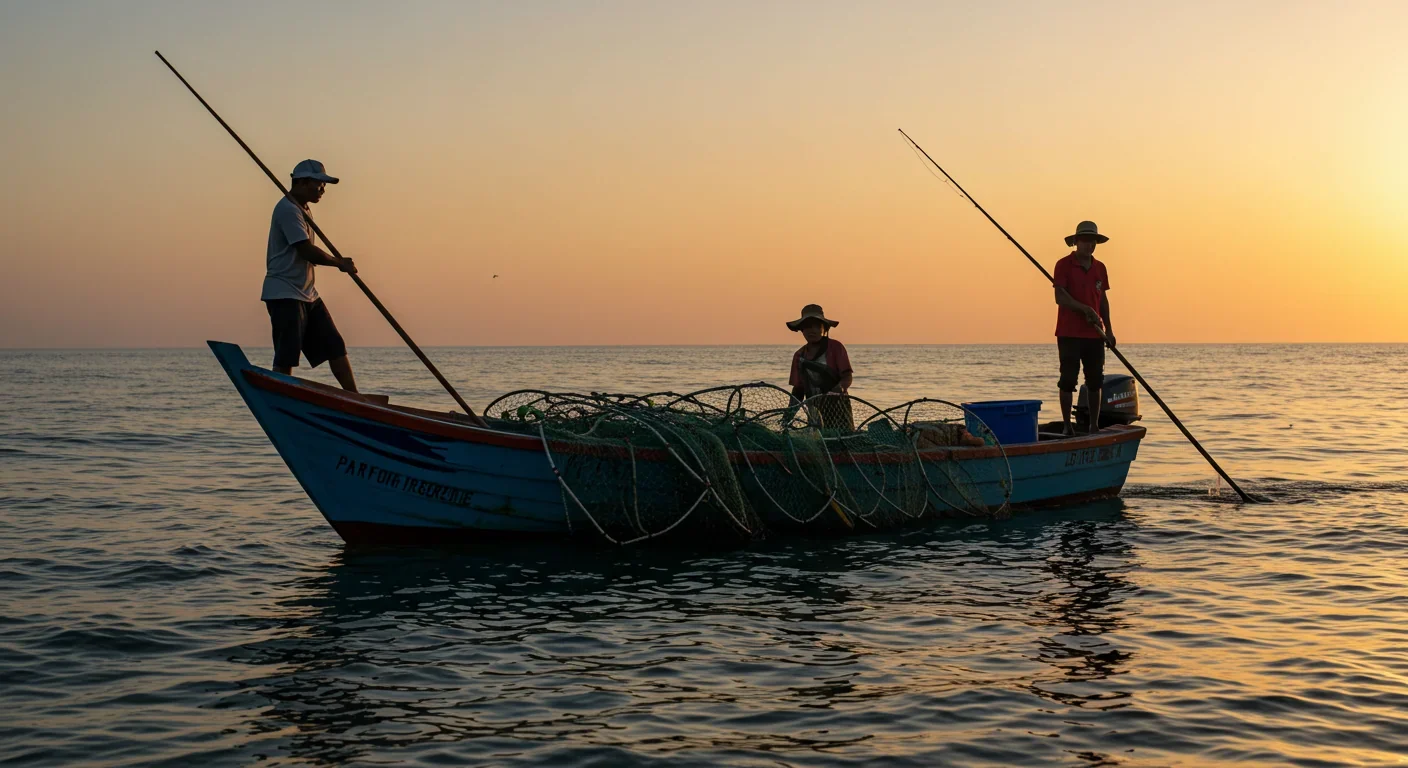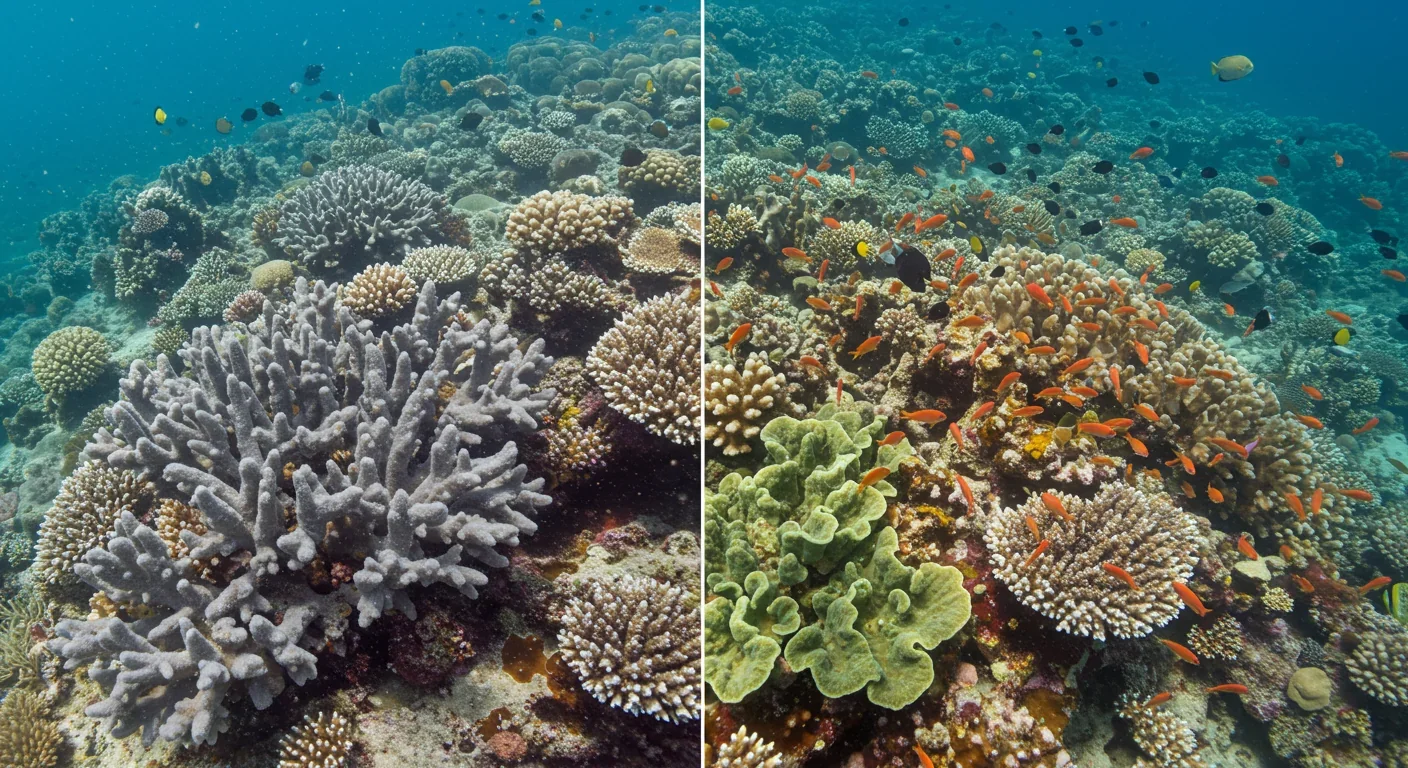Underground Air Storage: Renewable Energy's Hidden Battery

TL;DR: Marine protected areas can work spectacularly when enforcement is strong, communities benefit economically, and placement targets critical habitats—but most MPAs fail because governments rush to meet percentage targets with underfunded paper parks that lack enforcement, community buy-in, or strategic location.

In 1995, a small fishing village in Mexico's Baja California made a radical bet. The people of Cabo Pulmo decided to stop fishing entirely in their surrounding waters and turn their 71-square-kilometer coastal zone into a strict no-take marine protected area. At the time, the reef was dying, fish were scarce, and the community faced economic ruin. Twenty years later, fish biomass had exploded by 463%, the reef was thriving, and dive tourism brought more income than fishing ever did. It looked like the perfect conservation success story.
Except the story of marine protected areas isn't that simple. For every Cabo Pulmo, there's a paper park that exists only on maps while illegal trawlers scrape the seafloor. For every Phoenix Islands Protected Area celebrated as a triumph, there's a fishing community displaced without compensation, watching their ancestral waters become off-limits. The question isn't whether no-take zones can work—it's when they work, why they sometimes fail spectacularly, and what that means for the global push to protect 30% of our oceans by 2030.
The ecological science is surprisingly clear: when enforcement works, no-take MPAs deliver. Studies across 144 marine reserves found fish biomass increased an average of 48% inside protected zones compared to just 9% in fished areas. In the Great Barrier Reef's green zones, strictly protected sections showed biomass gains of 31% over lightly fished comparison sites. The Philippines documented 150% increases in catch rates in waters adjacent to marine sanctuaries, because protected zones function as fish nurseries that spill over into surrounding areas.
But that word—when—carries enormous weight. The same research that celebrates these wins also reveals the conditions under which protection becomes meaningless. Brazil's massive Atlantic MPAs, covering over 100,000 square kilometers and among the world's largest, showed persistent illegal fishing in 12-38% of their no-take zones after establishment. In one reserve, fishing density actually increased after protection was declared, a phenomenon researchers call the "squeeze factor"—when displaced boats crowd into smaller legal areas or ignore boundaries entirely.
Size doesn't equal success. Location, enforcement capacity, and community buy-in matter far more than square kilometers on a map. Cabo Pulmo succeeded not because it was large, but because local fishing families voluntarily patrolled their own waters, turning poachers into park rangers. The Great Barrier Reef's management works because Australia invests millions in surveillance technology and employs dedicated enforcement staff. Remove those conditions, and you get what conservation biologists grimly call "paper parks"—protected areas that exist in legislation but not in reality.
Here's the uncomfortable truth: most MPAs lack adequate enforcement. Even Cabo Pulmo, despite its success, operates with limited resources that can't fully police the park boundaries. The Phoenix Islands Protected Area spans 408,250 square kilometers of remote Pacific Ocean—roughly the size of California—with a protection budget that wouldn't cover policing a mid-sized city. Satellite monitoring helps, but boats can turn off transponders. Aerial patrols are expensive. Physical enforcement at sea requires vessels, fuel, and personnel that most developing nations can't afford.
The result is a global network of marine reserves with wildly inconsistent protection. Greenpeace research reviewing 81 publications across 37 countries found fisheries and tourism benefits in most cases, but that same research glosses over the reserves that simply don't function. When scientists analyzed large-scale Atlantic MPAs using vessel monitoring data, they found fishing activity continued in areas supposedly off-limits. The multiple-use zones—where some fishing is allowed—often saw increased fishing intensity, defeating the conservation purpose.

What works? Community-based enforcement, primarily. Fiji's Locally Managed Marine Areas achieved a 260% increase in fish populations within five years, coupled with a 35% rise in income for fishing families. Local communities patrolled their own waters, because they had skin in the game. The Coral Reef Alliance emphasizes that the most successful MPAs integrate traditional ecological knowledge with scientific management, creating hybrid governance where communities co-manage with government agencies.
Technology helps, but only when paired with political will. Satellite tracking can identify illegal vessels, but someone still needs to intercept them. Drones can survey reefs, but prosecution requires functioning legal systems. The Marine Biodiversity Science Center notes that enforcement challenges are most severe in large, remote MPAs where technological and resource gaps exist. Size without capacity undermines everything.
The fishing industry's biggest fear about no-take zones turns out to be mostly wrong. Research finds no evidence of net costs to fisheries from MPAs anywhere, at any time. Yes, boats are displaced from protected waters. But spillover effects—where fish from the reserve migrate to adjacent fishing grounds—typically offset those losses within 3-5 years. Fish populations in waters adjacent to MPAs can increase by up to 40% within five years of protection.
The economic winners are often surprising. The Great Barrier Reef Marine Park generates $5.4 billion annually through tourism, supporting 64,000 jobs—far more than reef fishing ever provided. Cabo Pulmo's dive shops employ former fishermen as guides, earning more than they did catching fish. Local residents work as rangers, educators, and research assistants. Studies across 25 countries documented commercial fisheries benefits, and 24 countries saw tourism gains.
But these economic transitions require upfront investment and don't happen automatically. Displaced fishermen need retraining. Communities need startup capital for tourism infrastructure. Someone has to build the dive centers, print the guidebooks, train the guides. When governments create MPAs without funding these transitions, economic hardship follows. The fishermen who lose access without gaining alternatives become the fiercest opponents of conservation, and rightfully so.
The timeline matters too. Spillover benefits take 3-5 years to materialize. That's three to five years of reduced income while fish populations recover. Few small-scale fishing operations can absorb that hit without assistance. Successful MPAs provide bridge funding, alternative livelihoods, or compensation during the transition period. Failed MPAs impose costs and hope for the best.
Not all ocean real estate is equal. Cabo Pulmo's reef was 20,000 years old, the northernmost coral reef in the eastern Pacific, situated in the Sea of Cortez's extraordinary biodiversity. Protecting that specific location delivered outsized returns. By contrast, establishing a massive MPA in biologically sparse open ocean produces fewer tangible benefits, though it may help meet percentage-based protection targets.
Strategic placement can multiply effectiveness. MPAs work best when they:
Protect critical habitats like spawning grounds, nurseries, or coral reefs where biodiversity concentrates. The Great Barrier Reef's zoning system protects 344,400 square kilometers of critical marine habitat, including breeding areas for hundreds of species.
Connect to other protected areas creating migration corridors. Isolated MPAs function as islands; connected networks allow genetic exchange and population movement. Climate change makes connectivity more critical, as species shift ranges to track temperature.
Include adequate depth range because many species move vertically through water columns. Protection that covers surface waters but not deeper habitats leaves populations vulnerable.
Encompass entire ecosystems rather than arbitrary boundaries. Predators range widely; protecting prey but not predators (or vice versa) creates incomplete conservation.
Research on seabed habitats in the Great Barrier Reef found that local environmental conditions—water depth, substrate type, reef structure—had stronger effects on fish communities than protection status. This doesn't mean protection fails; it means that protecting the right places matters enormously.
The global 30x30 target—protecting 30% of oceans by 2030—raises an uncomfortable question: 30% of what? Thirty percent of the ocean by area could mean vast tracts of open water with minimal biological activity, or it could mean the most biodiverse coastal and reef systems on the planet. The two approaches have radically different conservation value. When governments rush to meet percentage targets, they're incentivized to protect remote, low-conflict areas rather than the overfished coastal zones that need protection most.
The binary choice between "complete protection" and "business as usual" increasingly looks outdated. Hybrid approaches are emerging:
Multiple-use zones allow specific low-impact activities while prohibiting destructive practices. The Great Barrier Reef uses this extensively, with different colored zones for different activities: green for strict protection, yellow for limited fishing, blue for general use. The system is complex to manage but accommodates diverse stakeholders.
Dynamic management closes areas temporarily during spawning seasons or when populations dip below thresholds, then reopens them when conditions improve. This requires real-time monitoring and adaptive governance, but it can maintain protection while allowing sustainable use.
Gear restrictions ban destructive fishing methods (bottom trawling, dynamite fishing) while permitting selective techniques (hook-and-line, spearfishing). Evidence suggests this approach produces lower ecological benefits than full no-take protection but faces less political opposition.
Community-managed marine areas like Fiji's LMMAs put local communities in charge of setting and enforcing rules. These often blend traditional practices with scientific guidance, creating culturally appropriate conservation that communities actually support.

The trade-off is clear: complete no-take zones deliver greater ecological benefits and have lower management costs than complex multi-use regulations. But in contexts where total bans are politically impossible or would cause severe hardship, hybrid models may be the only feasible path forward. Perfect protection that never gets implemented helps nothing.
Here's the problem: we're protecting areas while the ocean itself is changing. Climate change affects MPA effectiveness in ways scientists are only beginning to understand. Warming waters push species toward the poles; an MPA designed to protect tropical fish populations may end up protecting empty water as those species move north. Coral bleaching events can devastate reefs faster than protection can restore them.
Protected areas can't shield marine life from ocean acidification, which affects all waters regardless of fishing pressure. They can't block marine heatwaves. What protection can do is reduce cumulative stressors. A reef free from fishing pressure and pollution is more resilient to bleaching than a stressed reef. MPAs become refugia—places where populations remain robust enough to potentially reseed damaged areas after climate shocks.
This creates new design requirements. Static boundaries make less sense when species are moving. Climate-smart MPAs need to incorporate:
Climate refugia where local conditions (deep water, upwelling currents, shade) buffer against warming. Scientists are mapping these areas to prioritize protection for populations with the best chance of surviving temperature increases.
North-south connectivity allowing species to migrate along climate gradients. Protecting a string of sites at different latitudes creates stepping-stones for range shifts.
Adaptive management frameworks that allow boundaries to shift as conditions change. This is legally complex—fishing rights, territorial waters, and treaties all complicate boundary adjustments—but it's increasingly necessary.
The uncomfortable reality is that climate change will render some MPAs less effective over time, regardless of how well they're managed. That doesn't mean protection is futile; it means we need to plan for a moving target while simultaneously cutting emissions to slow the underlying problem.
After reviewing hundreds of MPAs worldwide, the pattern is clear. Success comes from:
Strong enforcement, whether through government resources or community patrols. This matters more than size. A small, well-policed reserve outperforms a massive paper park.
Community buy-in, either through co-management, compensation, or alternative livelihoods. When locals benefit from protection, they become the best enforcers. When they're excluded and impoverished, they become poachers.
Strategic location protecting critical habitats, connectivity corridors, or high-biodiversity areas. Protecting empty ocean is cheap and politically easy but delivers minimal conservation value.
Adequate funding not just for enforcement but for the entire ecosystem of management, monitoring, stakeholder engagement, and economic transition. Underfunded MPAs consistently underperform.
Scientific monitoring to track whether the MPA is actually working and allow adaptive management. Without data, you're flying blind.
The question isn't whether marine protected areas work—we know they can. The question is whether we're willing to implement them the right way: adequately funded, strategically located, fairly managed, and rigorously enforced. When those conditions align, the results can be extraordinary. When they don't, we get false victories: percentages on paper that protect little in reality.
The global push for 30x30 protection creates an opportunity and a risk. The opportunity: mobilize political will and funding to protect critical marine ecosystems before they collapse entirely. The risk: rush to meet numeric targets with poorly designed, underfunded MPAs that look good in press releases but fail in practice.
We know what works now. Cabo Pulmo-style community engagement, Great Barrier Reef-level funding, Fiji's integration of traditional knowledge, strategic targeting of biodiversity hotspots, real enforcement with real consequences. The question is whether governments will commit the resources and political capital to do it right, or settle for cheap, easy protections that fail the ocean while appearing to save it.
The fishing village of Cabo Pulmo made their bet in 1995. It took years of sacrifice, community solidarity, and uncertain outcomes. Today their waters teem with life, their economy thrives on tourism, and their children inherit abundance instead of collapse. That success is real. It's also not automatic, not easy, and not guaranteed. Every protected area faces that same choice: commit fully to making it work, or watch another paper park join the list of conservation's broken promises.
The ocean doesn't care about our percentages and targets. It responds to what we actually do—where we fish, what we catch, which waters we protect, and how seriously we enforce those protections. The evidence is clear enough now. What remains is the political will to act on it.

MOND proposes gravity changes at low accelerations, explaining galaxy rotation without dark matter. While it predicts thousands of galaxies correctly, it struggles with clusters and cosmology, keeping the dark matter debate alive.

Ultrafine pollution particles smaller than 100 nanometers can bypass the blood-brain barrier through the olfactory nerve and bloodstream, depositing in brain tissue where they trigger neuroinflammation linked to dementia and neurological disorders, yet remain completely unregulated by current air quality standards.

CAES stores excess renewable energy by compressing air in underground caverns, then releases it through turbines during peak demand. New advanced adiabatic systems achieve 70%+ efficiency, making this decades-old technology suddenly competitive for long-duration grid storage.

Our brains are hardwired to see patterns in randomness, causing the gambler's fallacy—the mistaken belief that past random events influence future probabilities. This cognitive bias costs people millions in casinos, investments, and daily decisions.

Forests operate as synchronized living systems with molecular clocks that coordinate metabolism from individual cells to entire ecosystems, creating rhythmic patterns that affect global carbon cycles and climate feedback loops.

Generation Z is the first cohort to come of age amid a polycrisis - interconnected global failures spanning climate, economy, democracy, and health. This cascading reality is fundamentally reshaping how young people think, plan their lives, and organize for change.

Zero-trust security eliminates implicit network trust by requiring continuous verification of every access request. Organizations are rapidly adopting this architecture to address cloud computing, remote work, and sophisticated threats that rendered perimeter defenses obsolete.